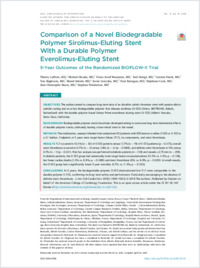Comparison of a novel biodegradable polymer sirolimus-eluting stent with a durable polymer everolimus-eluting stent: 5-year outcomes of the randomized bioflow-ii trial
- Lefèvre, Thierry Department of Interventional Cardiology, Hopital Jacques Cartier, Massy, France
- Haude, Michael Medical Clinic I, Städtische Kliniken Neuss, Lukaskrankenhaus, Neuss, Germany
- Neumann, Franz-Josef Department of Cardiology and Angiology, Universitäts-Herzzentrum Freiburg?Bad Krozingen, Germany
- Stang, Karl Department of Cardiology, Campus Charité Mitte, Charité ? Universitätsmedizin Berlin, Germany
- Skurk, Carsten Department of Cardiology, Charité Campus Benjamin Franklin, Berlin, Germany
- Slagboom, Ton Department of Cardiology, Onze Lieve Vrouwe Gasthuis, Amsterdam, the Netherlands
- Sabaté, Manel Department of Cardiology, Hospital Clínic, Thorax Institute, Barcelona, IDIBAPS, University of Barcelona, Spain
- Goicolea, Javier Department of Cardiology, Hospital Puerta de Hierro, Madrid, Spain
- Barragan, Paul Department of Cardiology, Polyclinique les Fleurs, Ollioules, France
- Cook, Stéphane Department of Cardiology, Hospital and University of Fribourg, Switzerland
- Macia, Jean-Christophe Department of Cardiology, University of Montpellier, Montpellier, France
- Windecker, Stephan Department of Cardiology, Bern University Hospital, Bern, Switzerland
-
28.05.2018
Published in:
- JACC: Cardiovascular Interventions. - 2018, vol. 11, no. 10, p. 995–1002
English
ObjectivesThe authors aimed to compare long-term data of an ultrathin cobalt- chromium stent with passive silicon carbide coating and an active biodegradable polymer that releases sirolimus (O-SES) (Orsiro, BIOTRONIK, Bülach, Switzerland) with the durable polymer-based Xience Prime everolimus-eluting stent (X-EES) (Abbott Vascular, Santa Clara, California).BackgroundBiodegradable polymer stents have been developed aiming to overcome long-term detrimental effects of durable polymer stents, ultimately leaving a bare-metal stent in the vessel.MethodsThis multicenter, assessor-blinded trial randomized 452 patients with 505 lesions to either O-SES or X-EES in a 2:1 fashion. Endpoints at 5 years were target lesion failure (TLF), its components, and stent thrombosis.ResultsTLF occurred in 10.4% (n = 30) of O-SES patients versus 12.7% (n = 19) of X-EES patients (p = 0.473), overall stent thrombosis occurred in 0.7% (n = 2) versus 2.8% (n = 4) (p = 0.088), and definite stent thrombosis in 0% versus 0.7% (n = 1) (p = 0.341). Post hoc analysis was performed in diabetic patients (n = 128) and vessels ≤2.75 mm (n = 259). In diabetic patients, the O-SES group had numerically more target lesion revascularizations (13.5% vs. 4.5%; p = 0.138), but fewer cardiac deaths (1.3% vs. 6.9%; p = 0.089) and stent thrombosis (0% vs. 6.9%; p = 0.039). In small vessels, the O-SES group had a significantly lower 5-year mortality (3.7% vs. 11.3%; p = 0.022).ConclusionsAt 5 years, the biodegradable polymer O-SES demonstrated low TLF rates comparable to the durable polymer X-EES, confirming its long-term safety and performance. Particularly encouraging is the absence of definite stent thrombosis.
- Faculty
- Faculté des sciences et de médecine
- Department
- Médecine 3ème année
- Language
-
- English
- Classification
- Medicine
- License
- License undefined
- Identifiers
-
- RERO DOC 322919
- DOI 10.1016/j.jcin.2018.04.014
- Persistent URL
- https://folia.unifr.ch/unifr/documents/307127
Statistics
Document views: 105
File downloads:
- coo_cnb.pdf: 176
